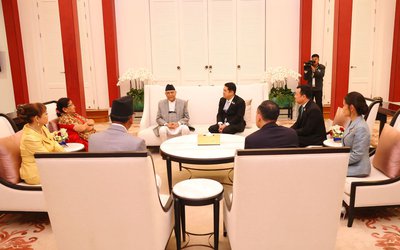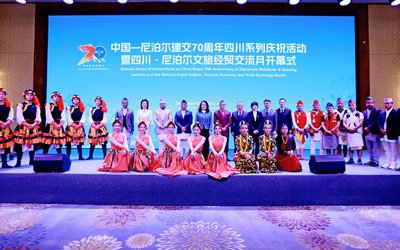
The large-scale relief operation launched in the wake of the devastating 7.8 magnitude earthquake, which struck Nepal on 25 April, continues to intensify. National and local authorities are leading the effort, supported by the United Nations, humanitarian partners, the international community, private sector and volunteers.
“The momentum is there. We have been making substantial progress for the past month,” said Jamie McGoldrick, Humanitarian Coordinator in Nepal. Considering the conditions and complexities, we are now well positioned to assist all the affected communities.”
It is estimated that more than 30 per cent of Nepal’s population, in 39 out of the country’s 75 districts have been affected. In the immediate aftermath of the first earthquake, the Government of Nepal, supported by the United Nations and the international community, launched a comprehensive relief operation.
The topography of Nepal is the major challenge. Some 315,000 people in the 14 most affected districts remain in areas inaccessible by road, while 75000 of cannot be reached even by air. Aid delivery is complemented with traditional methods, to work around challenges. Elite climbers and porters joined the effort, setting off on foot from the areas where aid is dropped off. Five logistics and three coordination hubs, together with an established humanitarian staging area and mobile storage units, allow the responders to optimize the flow of relief goods, both air and by road.
“Logistic is one of the major challenges in delivering the foods in various affected areas. With the departure of foreign rescue soldiers and their helicopters, there will likely be short supply of helicopters,” said Richard Ragan, Emergency Coordinator WFP. “Despite all difficulties, we have been providing much needed food to victims.”
With monsoon season just two/ three weeks away, the race is on to provide hundreds of thousands of families with roof over their heads. Food and other items and services are also urgently required to ensure the survival of people affected by the back-to-back quakes.
“We don’t have much time left to achieve what we set out to accomplish,” aid McGoldrick.” But with the right support at the right time, we can assist people who desperately need our help, even those in the remote hard-to-reach places.”
The United Nations and humanitarian partners aim to provide emergency shelter to more than 350,000 families whose homes were destroyed. Some 1.9 million people are in need of immediate food assistance and 1.5 million people require sanitation and hygiene support. On-going medical care is needed for 2 million people, while effective surveillance and response measures must be deployed to mitigate any possible disease outbreaks. Providing immediate learning spaces and support to some 1.1 million children is an immediate protective and psycho-social measure for children and will allow families to return to livelihood activities.
“Shelter cluster is focusing on the delivery of emergency shelter materials to 350,000 households across 14 priority districts and supporting self-recovery. Nearly 120,000 our targeted households have been reached to date and this number is increasing daily as distribution are rapidly scaling up,” said Shelter Cluster Coordinator Victoria Bannon.
According to a press release issued by United Nations, to date only US$92.4 million or 22 percent of what is required for the response, was received against the $423 million humanitarian appeal, launched by the UN and partners on 19 April. A further $33 million (or additional Eighth percent) in support of the ongoing response was received by partners outside of the Flash Appeal.
The focus of the on-going humanitarian operation is to ensure that those affected are provided with the basics, to ensure their survival through the monsoon season. This includes providing them with shelter, which is our top-most priority, food and other items and services necessary for their subsistence. Innovative techniques combining standard aid delivery with traditional methods used by the Nepalese people are used by responders to reach vulnerable communities in far flung, mountainous areas – many of which were the most affected by the disastrous events.
Funding for the relief operations remains insufficient, as the humanitarian community races against the clock to ensure shelter is provided to those without homes and pipelines are in place in the next 2-3 weeks, before the monsoon season begins.
- IME GROUP: Expands Into Paper Industry
- Mar 24, 2025
- CPN UML: Instigated By India
- Mar 23, 2025
- ADB’S CHIEF ECONOMIST: Nepal Reduces Poverty
- Mar 11, 2025
- FM DR. DEUBA: A Successful Visit
- Mar 11, 2025
- MD GHISING: Target Of Personal Grudge
- Mar 09, 2025















